From planting native plants to turning a section of lawn into a native meadow, community conservation is not just words for members of the Friends of Hopewell Valley Open Space (FoHVOS), its partners and the residential homeowners involved.
Instead, it has been all about action as the organization’s community conservation program has involved Hopewell Valley Regional School District (HVRSD) schools, municipalities, hospitals, other nonprofit organizations, and residential properties in stewardship efforts by restoring pieces of land and growing environmental resources.
These efforts are now expanding to working on an updated – Hopewell Valley Community Conservation and Resiliency Plan – that would be a science based and public informed plan on restoration practices for the entire valley. The updated plan would be designed to help people with agricultural land, corporate campuses, and those who are residential homeowners.
Mark and Samantha Bean and their residential property in Hopewell is a prime example of residential community conservation FoHVOS spotlights.
The property consists of rain gardens, native plants, a nature garden with cup plants and elderberry, a small native wildflower meadow and the property abuts a one-acre detention basin that the Bean family turned into a larger wildflower meadow.
They call their more than two-acre property – Flutter by Meadows.
“I would say FoHVOS is a pioneer in the idea of performing conservation on property that is outside of their preserve,” said Jennifer Rogers, executive director of FoHVOS. “For the idea that partnering and using lands that are outside of preservation really make a big impact in conservation.
“Our team of stewardship staff have been doing this for over 12 years and have partnered with county and municipal government, and schools. We also provide services for homeowners to help them (like the Bean family) bring conservation practices to their yard.”
Rogers explained that at this point in the organization’s community conservation program they have a lot of residential homeowners who are [leaning] a little more towards the do it yourself (DIY). There are 286 Hopewell Valley homes that have currently joined the program and combined consist of 3,870 acres, according to FoHVOS.
People have to be FoHVOS members to be a part of their residential community conservation service, which is a free service and consultation where a member of FoHVOS staff visits a property for one to two hours helping guide homeowners with advice and help them plan in various areas such as native plants, invasive species management, forest restoration, wildlife restoration, and deer management.
When the Bean family moved to Hopewell Township in 2007 there were just some contractor grade plantings and lawn grass on the property. They also discovered in their backyard that there was a one-acre detention basin with concrete channels running through it, lawn with weeds around it, and a fence around that basin which was consistently in disrepair.
The one-acre detention basin turned out to be owned by the Homeowners Association (HOA).
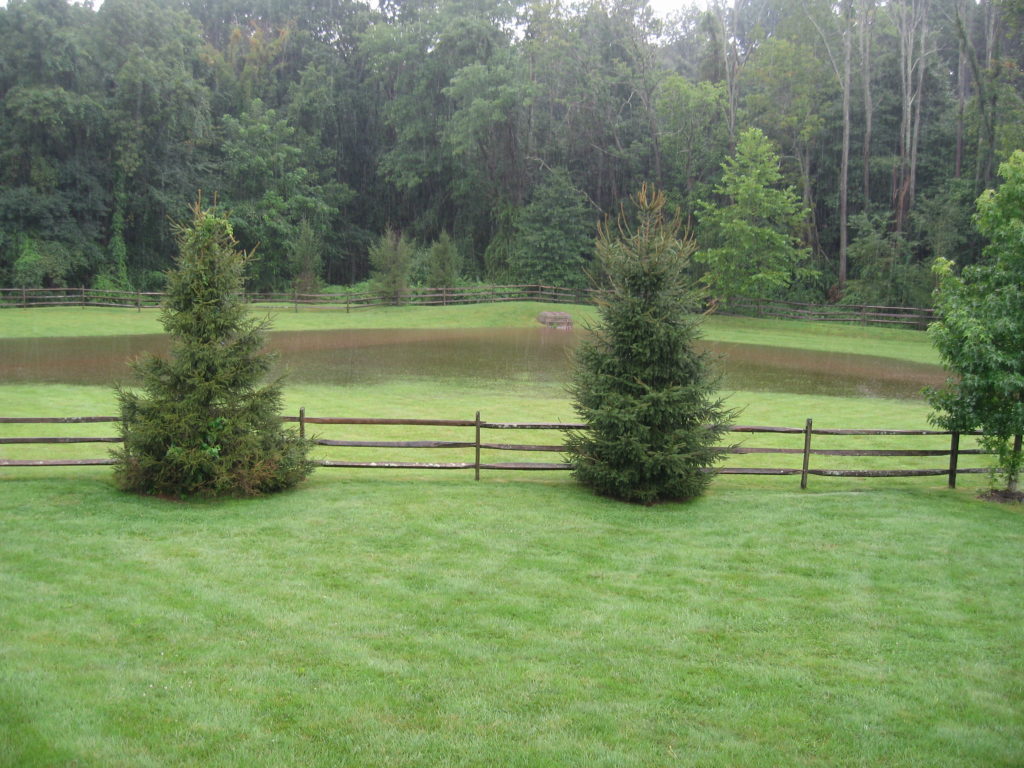
In 2014, Mark Bean was driving past a property and saw wildflowers. That sparked the idea of having wildflowers on their family property. When he attended the Hopewell Harvest Fair and came across a FoHVOS booth he noticed a picture of a meadow restoration at the organization’s Thompson Preserve.
“I said, ‘That is what I want in my backyard’ and one of the FoHVOS board members says ‘Be part of Community Conservation program and we will have our director of stewardship Dr. Mike Van Clef come out to your house and give you ideas on what to do,'” Mark Bean recalled.
Van Clef agreed that the detention basin would be great for a meadow and gave the name of someone the Bean family could contact. Additionally, Bean described how Van Clef made suggestions on plants he would not recommend planting more of and other recommendations.
“While these native plants are beautiful, bring biodiversity, and interests they also assist with the water retention of these basins,” Rogers said of the native wildflower meadow. “Because if you are treating your basin like you are treating your lawn it acts as an impermeable surface and doesn’t take in any water and allow the soil to hold on to it slowly filtering it back into waterways.”
After attempting to create their vision themselves, they were given another name by Van Clef to help give them some designs and help them in the process.
Over time, piece by piece the Bean’s property came together.
To turn the one-acre detention basin into a native wildflower meadow Samantha Bean said they first had to get approvals from the HOA to get the native plants planted since they did not own the one-acre and also had to get approval from Hopewell Township, which had an easement on the detention basin. They received approvals from both.
The Bean’s paid for the work to be done and asked the HOA to maintain the cut once a year.
She said, “then we planted the meadow and waited a good while for the meadow to grow because it takes a year before it gets established. Over time, we don’t see those concrete channels anymore which is amazing. The whole land area is kind of shaped like a triangle.”
May 2015 was the meadow’s first growing season. By the second year, the meadow was bursting with flowers.
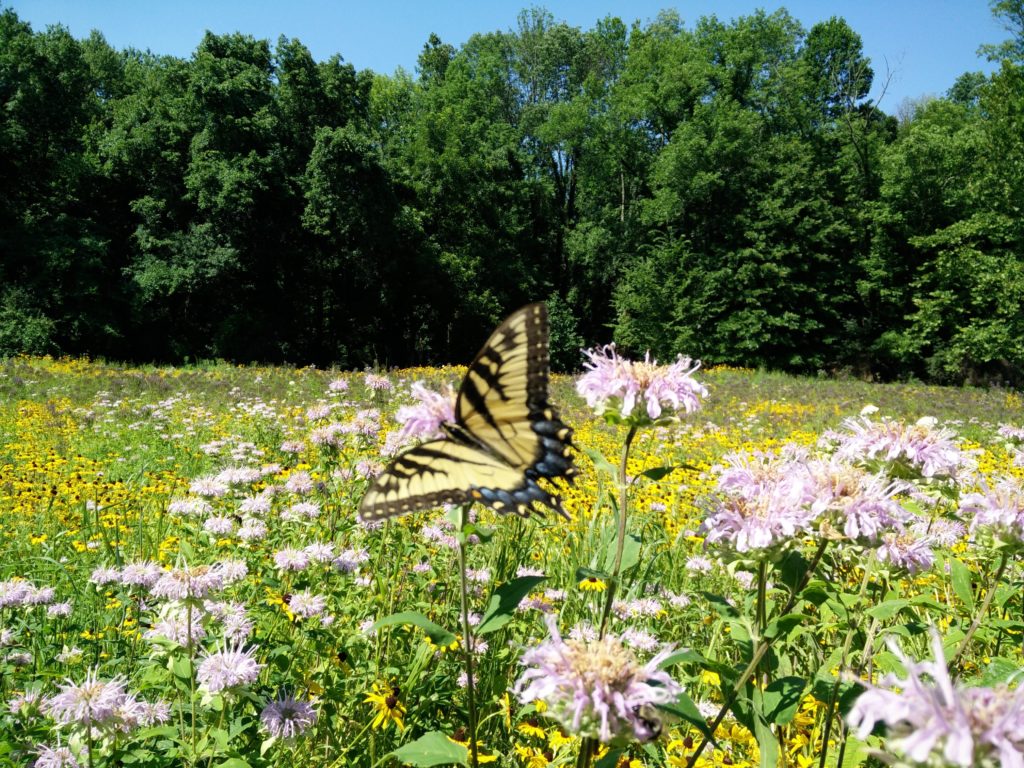
Native wildflower meadow in bloom.
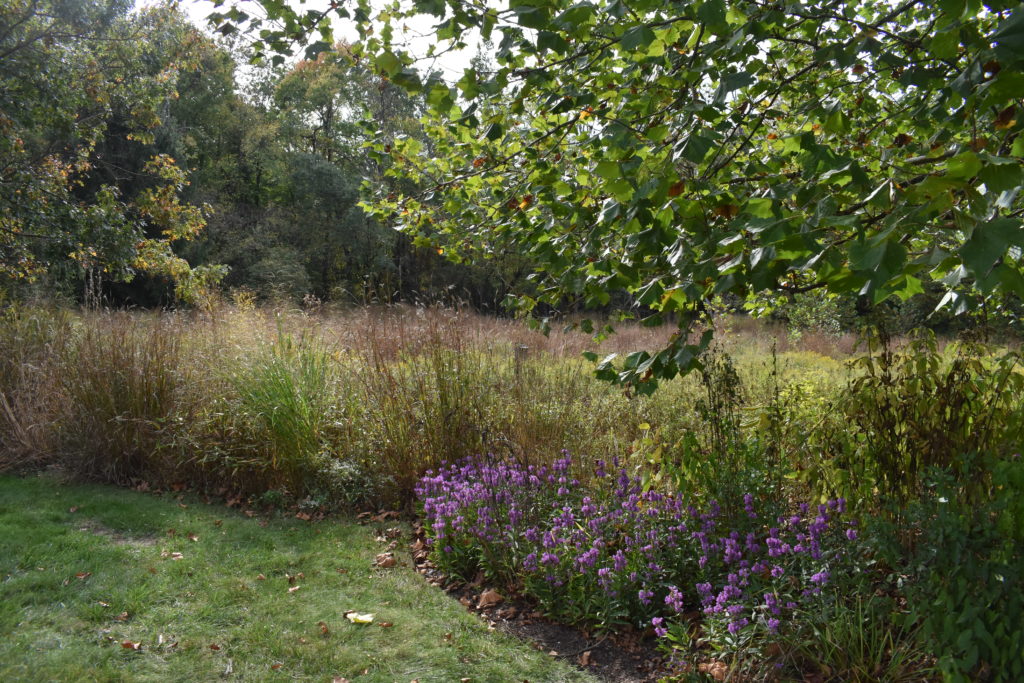
Native wildflower meadow on Oct. 4.
Samantha and Mark Bean added how they saw changes happening to their property after the meadow grew. The family started seeing different birds, butterflies, other insects and wild animals.
Other additions followed the meadow such as a rain garden in the front yard. The Bean’s noted that the native plants weren’t just pretty and attract nature, they also solve problems.
Their property is at the end of cul-de-sac that descends and when it rains the water flows down to the front of their home causing water to trickle a bit into the basement. The rain garden in the front yard next to the driveway collects some of the rain, if it gets too much there is a pipe that takes the water past their house to drain towards the detention basin in the back of the house.
“Our problems have been significantly reduced by the rain garden,” Samantha Bean said. “We have had heavier rains and much less problems. Nothing we can’t maintain with a simple shop vacuum.”
A nature garden sits in the back yard in view of a house kitchen window the Bean’s expanded to 11-feet to take in the back of the property. Through the window they are able to observe the comings and goings of birds and other animals through the nature garden, meadows, and lawn.
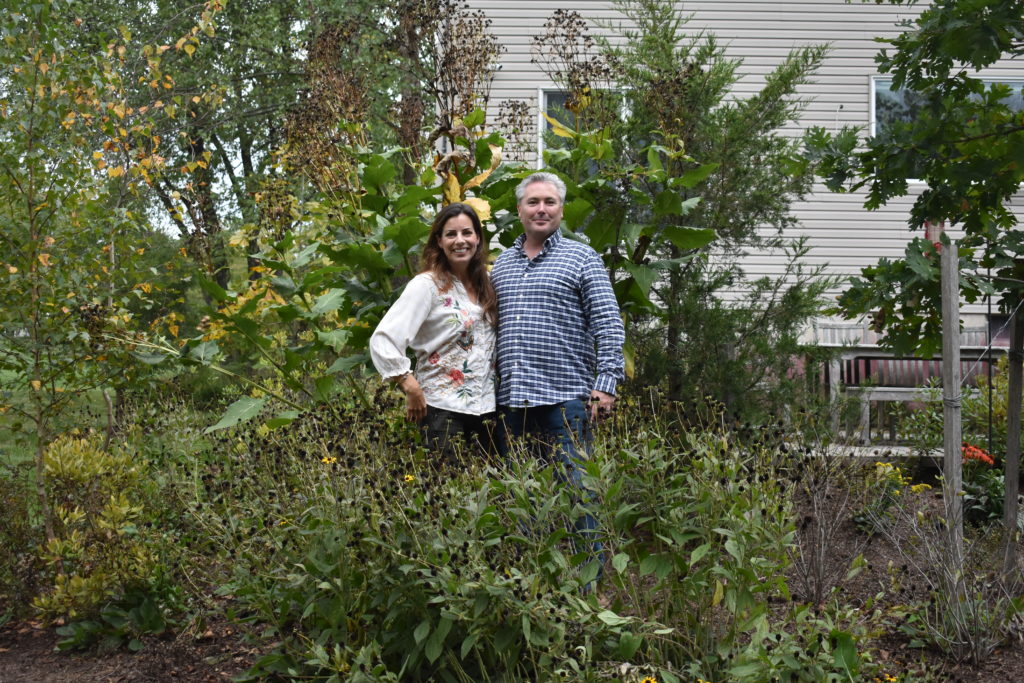

Samantha Bean (left), and Jennifer Rogers, executive director of FoHVOS, discuss plants in the Bean’s nature garden.
The Bean’s went on to plant native plants around their septic tank mound that fully covers it.
Additionally, there is a smaller meadow on the property that was also created by the Bean family. They had removed an invasive multiflora rose, which they learned from FoHVOS, to make way for the small meadow.
“All this perimeter was overgrown with invasive plants and I just cut year after year,” Mark Bean shared. “It was just learning about them through FoHVOS, because I did not know these were invasive plants to begin with.”
Samantha, Mark and their daughter Emma, who is going to be 13, have fallen in love with their “Flutter by Meadows” property and the changes that have occurred with the native plants, the meadows, and rain garden.
Samantha Bean captures photos and writes on her blog [flutterbymeadows] about the native plants, animals, and all that happens on the property.
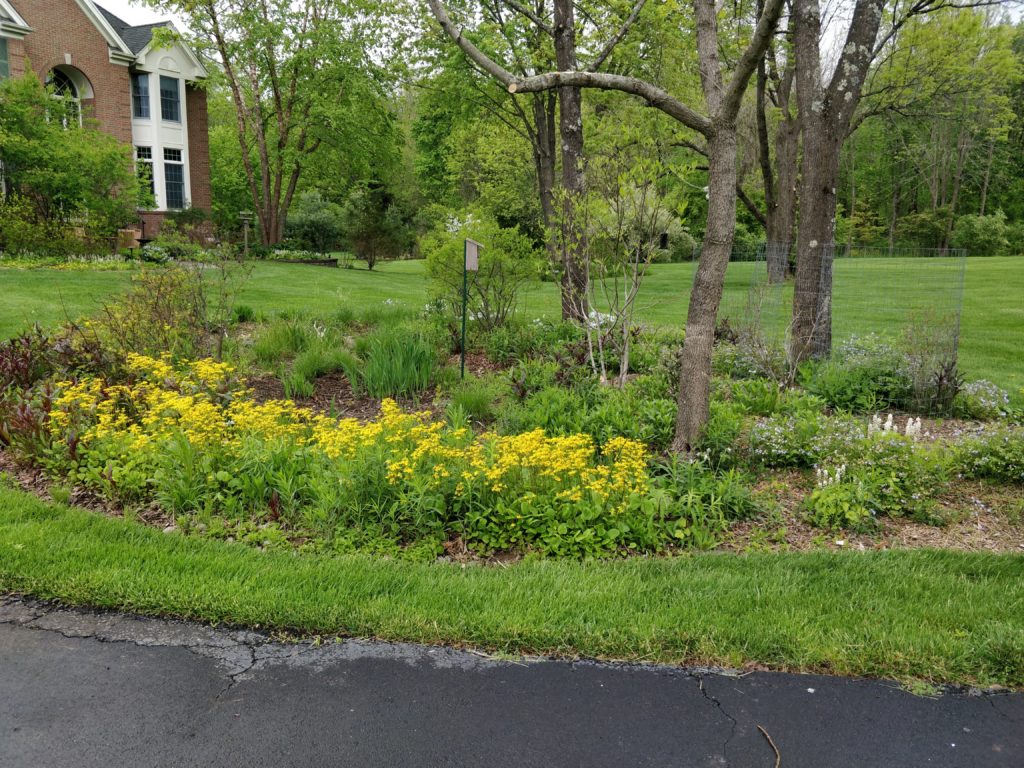
Hopewell Valley Community Conservation and Resiliency Plan
Beginning in 2025, FoHVOS will be working on updating a current community conservation plan.
The Hopewell Valley Community Conservation and Resiliency Plan is going to expand upon the organization’s current efforts of community conservation in few ways – one is the target audiences and landowners.
“We really want engage our agricultural community, whether that is people who own farmland, rent farmland and farm on it, or people who are in farmland assessments,” Rogers explained. “We also really want to begin working and growing our relationships with corporate campuses.
“Corporate campuses are large expanses of land that have incredible opportunity to provide protection and corridors for biodiversity. Also, do some of these same measures on their campuses to help with storm management on their property.”
The other pieces include FoHVOS expanding their focus of community conservation to include climate resiliency and watershed health.
“Native plants can assist with all of those pieces,” Rogers said, adding that they would be looking at a lot of similar efforts currently being done on larger tracts of land. “Now it is a matter of how we might program use and installation of native plants.”
Rogers described ideas as tree canopy lawns, converting lawns into meadows or retrofitting basins with native plantings for different levels of impact.
FoHVOS has received news this year that it has been awarded with a 2024 Land and Climate grant in the amount of $15,000 from the Open Space Institute and Land Trust Alliance.
“The funding from Open Space Institute and Land Trust Alliance is very generous,” Rogers said. “It did not require a match which is so wonderful for a small nonprofit. But, for us to fund this plan we are looking for additional funding. We need close to another $40,000.”
The plan will start in late autumn with small outreach to existing community conservation members. Meetings will begin in November as series of focus groups with current participants of the community conservation program to get feedback on expanding the plan.
Early next year, the organization will start talking to future participants in the program to get their input as well.
“The idea is to bring us all together through conservation and making an impact on waterways, reducing the effects of flooding and stormwater, increasing biodiversity, and helping create passive recreational opportunities for everyone here,” Rogers added.
A draft plan will be presented to FoHVOS constituents before finalizing the plan by March 2026.


